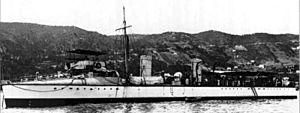HMS Cynthia (1898) facts for kids

HMS Cynthia
|
|
Quick facts for kids History |
|
|---|---|
| Name | HMS Cynthia |
| Ordered | 1896 – 1897 Naval Estimates |
| Builder | John I. Thornycroft & Company, Chiswick |
| Yard number | 321 |
| Laid down | 25 September 1897 |
| Launched | 3 September 1898 |
| Commissioned | 8 March 1900 |
| Fate | Sold for breaking, 29 April 1920 |
| General characteristics | |
| Class and type | Two funnel, 30-knot destroyer |
| Displacement |
|
| Length | 210 ft (64 m) o/a |
| Beam | 19 ft 9 in (6.02 m) |
| Draught | 7 ft 8 in (2.34 m) |
| Installed power | 5,700 shp (4,300 kW) |
| Propulsion |
|
| Speed | 30 kn (56 km/h) |
| Range |
|
| Complement | 65 officers and men |
| Armament |
|
| Service record | |
| Operations: | World War I 1914 - 1918 |
HMS Cynthia was a fast destroyer built for the Royal Navy. She was part of a group of ships known as "30-knot" destroyers because of their impressive speed. Launched in 1898, Cynthia served in different parts of the world, including the Mediterranean Sea. During World War I, she helped train sailors in gunnery. After the war, she was sold in 1920.
Contents
Building a Fast Destroyer
Cynthia was built at the John I. Thornycroft & Company shipyard in Chiswick, England, near the River Thames. Her construction began on 16 July 1896. She was launched into the water on 8 January 1898.
During her tests, Cynthia showed off her speed, reaching an average of 30.2 knots (about 56 kilometers per hour). This was very fast for a ship of her time! After her weapons were added in Portsmouth, the Royal Navy officially accepted her in June 1899.
Cynthia's Service Life
Cynthia began her active service on 8 March 1900 at Chatham. Her first job was with the Medway Instructional Flotilla, which was a group of ships used for training.
In August 1901, Cynthia was sent to join the Mediterranean Fleet. This meant she sailed to the Mediterranean Sea to work with other British warships there. She had a quick repair in May 1902 at Sheerness Dockyard. Later that month, she traveled to Gibraltar. In September 1902, she visited Nauplia in Greece with other ships from the fleet.
Becoming a D-Class Destroyer
In 1912, the Royal Navy decided to give letters to all its destroyer classes to make them easier to identify. Cynthia was placed in the D class. This class included other 30-knot destroyers that had two funnels. After September 1913, she was officially known as a D-class destroyer. To show this, the letter 'D' was painted on her hull near the bridge and on one of her funnels.
World War I Service
When World War I started in August 1914, Cynthia was stationed at The Nore, which was a naval base near Sheerness. She was assigned to HMS Actaeon, which was a school for training sailors in gunnery. Cynthia acted as a training ship, helping new recruits learn how to use naval guns. She continued in this important role throughout the entire war.
End of Service
After World War I ended, Cynthia was taken out of active service in 1919. She was kept in reserve until she was sold on 29 April 1920. Cynthia was bought by a company called Thos. W. Ward and was broken up for scrap metal at Rainham, Kent.
Pennant Numbers
Naval ships often have special numbers, called pennant numbers, to identify them. Here are the numbers Cynthia used during her service:
| Pennant number | From | To |
|---|---|---|
| N09 | 6 Dec 1914 | 1 Sep 1915 |
| D39 | 1 Sep 1915 | 1 Jan 1918 |
| D23 | 1 Jan 1918 | 29 Apr 1920 |

